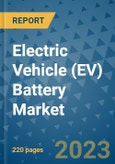The global automotive industry is experiencing a paradigm shift towards sustainable mobility solutions, with electric vehicles (EVs) at the forefront of this revolution. The EV market has witnessed significant growth in recent years, driven by rising environmental concerns and changing climatic conditions. Electric vehicles offer a cleaner and more sustainable mode of transportation, leading to a steady and balanced shift from conventionally powered vehicles to EVs, stimulating the growth of the EV battery market.
Rising Demand for EVs:
With increasing pollution levels and the need for effective and sustainable transportation solutions, gasoline- and diesel-powered vehicles are facing challenges due to harmful emissions and high ownership costs. As a result, alternative fuel-powered vehicles, particularly electric vehicles, are gaining traction, especially in developed nations with favorable EV policies and infrastructures.Electric Vehicles for Emission Reduction:
The transportation sector, accounting for a significant share of total greenhouse gases (GHGs) globally, relies heavily on gasoline, leading to rising carbon emissions. Lack of a shift from internal combustion engine (ICE) vehicles in emerging economies like China and India could contribute to further carbon emissions growth. Electrification of vehicles has the potential to reduce emissions, minimize oil dependency, and control oil prices and volatility.Regulatory Support and Incentives:
Many countries, such as California, have implemented Zero Emission Vehicle (ZEV) programs to regulate emissions from ICE vehicles and promote electric vehicle adoption. Stricter emission norms in various countries have pushed automakers to prioritize better fuel efficiency with low carbon footprint, further boosting the demand for electric vehicles and EV batteries.Opportunities for Growth:
The presence of strong charging infrastructure networks in regions like Europe, China, and the U.S. has fueled the growth of the EV battery market. Despite a decline in overall vehicle sales during the COVID-19 pandemic, electric cars have outperformed traditional vehicles, demonstrating strong potential for the EV battery market. The rapid development of commercial vehicle electrification is also contributing to market growth.Supply Chain Disruption:
While the electrified vehicle market is expected to face several challenges, including regulatory policies and charging infrastructure, the disruption caused by the COVID-19 pandemic has also impacted battery makers and electronic component suppliers. However, pent-up demand and a shift towards personal vehicles are expected to support market growth.Lithium-Ion Batteries to Lead:
Technological developments have improved the efficacy of hybrid electric vehicles (HEV), plug-in hybrid electric vehicles (PHEV), and battery electric vehicles (BEV). BEVs are gaining traction due to higher adoption rates of cobalt-based EV batteries in passenger vehicles, particularly in China. European countries and China are expected to drive EV battery sales, with approximately half of car sales projected to be powered by electric powertrains by 2040.Tech Giants Driving Synergy:
Significant R&D investments have led to advancements in EV battery technology. Key players in the market are forming alliances, joint ventures, and mergers to develop cost-effective and sustainable solutions. Tech giants are collaborating with battery makers and researchers to innovate high-density EV batteries, contributing to the market's growth.Key Players:
Prominent players in the EV battery market include BYD Company Limited, Panasonic Corporation, Johnson Controls International PLC, SAMSUNG SDI Co., Contemporary Amperex Technology Co. Ltd., LG Chem, Ltd., and A123 Systems.Table of Contents
1. Executive Summary
2. Market Overview
3. Production Output and Trade Statistics, 2019 - 2022
4. Price Trends Analysis and Future Projects, 2019 - 2030
5. Global Electric Vehicle Battery Market Outlook, 2019 - 2030
6. North America Electric Vehicle Battery Market Outlook, 2019 - 2030
7. Europe Electric Vehicle Battery Market Outlook, 2019 - 2030
8. Asia Pacific Electric Vehicle Battery Market Outlook, 2019 - 2030
9. Latin America Electric Vehicle Battery Market Outlook, 2019 - 2030
10. Middle East & Africa Electric Vehicle Battery Market Outlook, 2019 - 2030
11. Competitive Landscape
12. Appendix
Companies Mentioned
- Contemporary Amperex Technology Co., Limited (CATL)
- LG Energy Solutions
- Panasonic Corporation
- BYD Company Ltd.
- Samsung SDI Co. Ltd.
- SK Innovation
- Hitachi Chemical Co. Ltd.
- GS Yuasa International Ltd.
- China Aviation Lithium Battery Co., Ltd. (CALB)
- Exide Industries Ltd.
- Gotion High-tech
- Automotive Energy Supply Corp. (AESC)
- Ruipu Energy Co.
- SVOLT
Methodology

LOADING...








